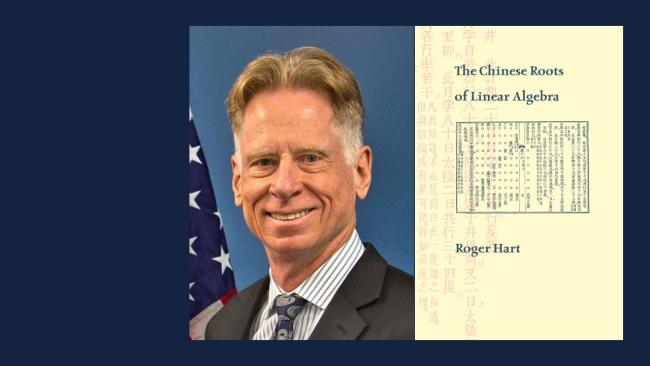
The Chinese Roots of Linear Algebra
The China Forum seminar on Wednesday 16 November 2022 was given by Dr Roger Hart, Professor of Chinese History and Director of the China Institute at Texas Southern University, and was based on his book The Chinese Roots of Linear Algebra.
Dr Hart’s lecture addressed the development of linear algebra in ancient China. He explained that linear algebra can provide solutions to n-terms in n simultaneous linear equations. Traditional accounts assert that linear algebra is exclusively Western in origin and attribute the solution of simultaneous linear equations to Leibniz (1646-1716), using the determinant method, and Gauss (1777-1855) using eliminations. However, Dr Hart demonstrated that solutions to sets of linear equations had been described in the Nine Chapters on Mathematical Methods (九章算術), which date from the first century CE, and that commentaries were made on this text by Liu Hui (263CE), Jia Xian (c1025), Yang Hui (1261), Dai Zhen (1774) and others. These texts show that the essentials of the methods used today in ‘Western’ linear algebra – augmented matrices, elimination and determinant-style calculations – were known by the first century in imperial China.
The main body of Dr Hart’s lecture explained the solutions set out in the Nine Chapters to complex sets of linear equations using 方程or number arrays, which are similar in appearance to the matrix formulation developed centuries later by Heisenberg and Jordan for quantum mechanics. The solutions use cross multiplication, elimination and back substitution. One example shown, called ‘Problem 18’, solved the prices of hemp, wheat, legumes, millet and beans from a posited relationship between these five variables. Dr Hart emphasised the visual nature of the solution, which was performed using counting rods on square arrays and relies on motor-learning of repetitive operations, similar to those used with an abacus. He also explained the ‘Well Problem,’ which concerns five families with various lengths of rope measuring the depth of a well. The nature of the problem is so unlikely ever to occur in practice that Dr Hart concluded that the array solutions were designed to address purely pretextual puzzles where the solution was known and the author worked back to the problem. Dr Hart also noted that 5 out of the 18 problems in the Nine Chapters have such a distinctive pattern that their occurrence in the later work of the Italian mathematician Fibonacci (c1170-1250) seems like a ‘fingerprint’ that could not have developed separately. Thus Dr Hart’s research shows that linear algebra came to Europe in the late Middle Ages having been first developed in imperial China.
The issues addressed in the Q&A session included the following: whether or not the ancient Chinese used linear algebra to solve practical problems in such areas as production planning, logistics or astronomy; what may have motivated the ancient Chinese to perform these calculations; what type of numerals were used in the solution to the linear problems; when linear algebra came to be applied to practical problem solving in Europe; whether there is a link between the back substitution methods used by the ancient Chinese and the determinant-model developed by the Europeans much later; whether or not the ancient Chinese might have been aware of the contributions to algebra and ‘algorithms’ by the Islamic civilisation; how Dr Hart came to study ancient Chinese history having started out with mathematics; and to what extent Chinese mathematics may be more advanced than the rest of the world and what advantages that might provide in current developments in the second quantum revolution.
Dr Roger Hart is a leading scholar of science and technology in China. His current research focus is contemporary (twenty-first century) China and the Second Quantum Revolution, especially the quantum internet, an area in which China has surpassed the U.S. He is a Professor of Chinese history and Director of the China Institute at Texas Southern University. His previous appointments include the Wilson Center, Seoul National University, University of Texas at Austin, University of Chicago, Institute for Advanced Study, Stanford, University of California at Berkeley, and Harvard. His previous awards include Fulbright U.S. Scholar, American Council of Learned Societies, National Endowment for the Humanities, and Andrew W. Mellon. His publications include two research monographs published by Johns Hopkins University Press. He earned his B.S. in mathematics from MIT and M.S. in mathematics from Stanford, and his Ph.D. in Chinese history and history of science from UCLA. He has lived in China for six years; his modern Chinese is near-native and his classical Chinese is excellent. He has spent the last three years studying the newly developed field of quantum information science. His website is www.rhart.org.





